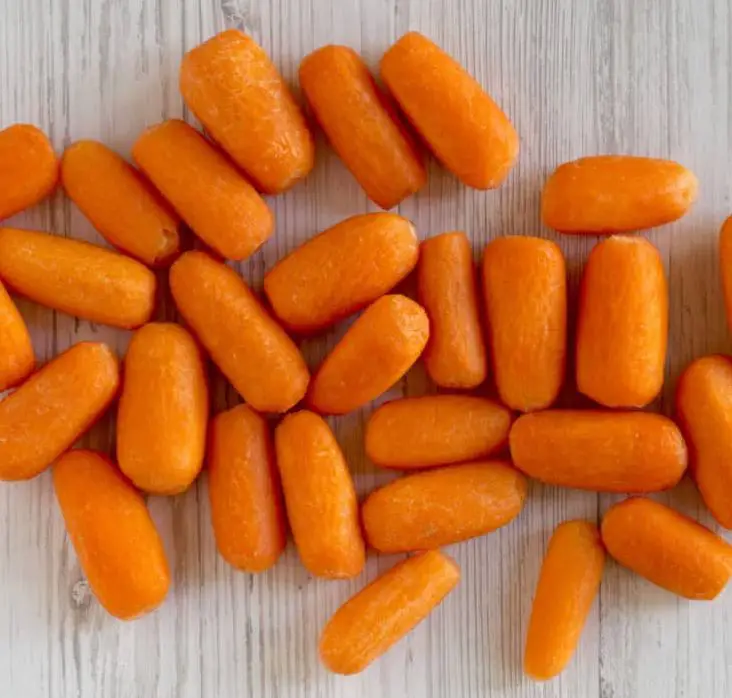When comparing baby carrots and regular carrots, you will notice differences not only in size but also in appearance and texture. If you don’t know how baby carrots are made or harvested, then you probably want to know how many baby carrots equal one carrot.
One medium to large-sized carrot will measure between 7 and 9 inches, allowing for 3 to 4 baby-cut carrots to be produced from one carrot. Baby carrots are cut into 2-inch pieces, then polished and shaved down to create the rounded product found in bags at the store.
The number of baby carrots per carrot will vary by the size of the carrot they are cut from. If you had no clue that babu carrots were cut from big carrots, then join the club. I didn’t know until I wrote this article! Since we’re here learning together, let’s learn some more about baby carrots/
Table of Contents
How Are Baby Carrots Made?
Before we get into how many baby carrots equal one carrot, we need to talk about how baby carrots are made.
Now don’t worry, it’s not going to be a birds and the bees conversation. There are two ways baby carrots are made, they are either cut from larger carrots or they are harvested when they are small.
Cut From Larger Carrots
The most common way to create baby carrots is to cut them from larger carrots which are usually called “baby-cut carrots”. According to the Carrot Museum, baby-cut carrots have become incredibly popular since their inception in the late 80s, they account for 70% of all carrot sales.
Because of this popularity, carrots have been crossed with and developed so that they grow to be skinnier and longer for higher baby carrot production.
Sometimes the carrots grown will be bent, malformed, or not up to the “pristine” standards that are found in the grocery store. These imperfect carrots are used to make baby-cut carrots which prevents smaller and differently shaped carrots from being thrown away and going to waste.
Once the perfectly imperfect carrots have been harvested, the larger carrots are cut into 2-inch baby carrots and shaved down to have the rounded edges we get in the packages.
And that’s all there is about this kind of baby carrot, but carrots are also made by harvesting carrots early.
Premature Carrots as Baby Carrots
Unlike baby-cut carrots, simple baby carrots are small carrots that have been harvested prematurely to maintain their sizing and flavor. These carrots are also highly sought after and are often more expensive because of their sweetness and tenderness as compared to the full-grown carrot.
The Chantenay carrot (originating in France) is one of the shortest carrot varieties at 5 inches, which produces a natural baby carrot. All carrots can be harvested at any edible length and be deemed baby carrots. Small carrots are also found in multiple colors, including yellow, whites, reds, and purples.
The real “baby carrots” are premature carrots that have been harvested to maintain their cute and small appearance.
Now that we’ve got that out of the way, let’s learn how many baby carrots equal one carrot.
How Many Baby Carrots Equal One Carrot?

Baby Carrots Per Large Carrot
Using larger carrots, which will fall closer to 10 inches in length, one can expect 4-5 baby-cut carrots to be produced. Some carrots may be larger than 10 inches, but this is uncommon. You can expect around a 2-inch cut for each carrot, but this can be slightly larger or smaller, depending on the manufacturer.
The 2-inch cut may not always be perfect for the following reasons:
- Carrot size variety: When carrots vary in size, the 2-inch cut will be standard for most of the carrot, but not always at the ends. If the cut is slightly different, they will use it. If the cut is too short, it may not be included in the bag.
- Peeling: To maintain their consistent rounded and peeled appearance, length may be compromised. This is especially true on the ends of the carrots that need to be shaped more dramatically than the bulk of the carrot.
- Manufacturing standards: Not all carrot producers will make baby-cut carrots the same way or at the same length. This size standard was established by a carrot farmer and has been replicated by many farmers to cater to their product needs (Source: Carrot Museum).
If you want to make baby-cut carrots yourself, the carrots found in grocery stores will typically allow for 3-4 baby carrots. Because they are often thicker than those used for processing, you may need to peel them thinly or create thinner baby cuts by slicing the carrots in half.
Baby Carrots Per Small Carrot
This same process is used for smaller carrots, but small carrots are not preferred as farmers cannot produce as many baby cuts per carrot. A small carrot would average around 5 inches, which can only yield 2-3 baby-cut carrots.
Because smaller carrots are not as efficient for baby-cut carrot production, they are best reserved for recipes and uses that call for using the entire small carrot.
How Many Baby Carrots in a Cup?
A cup is the standard for measuring out one serving of vegetables. One cup of baby carrots is equivalent to 12 baby carrots. If you are monitoring your serving sizes, this means that 12 baby carrots will be in one serving.
Cut baby carrots provide the same nutritional value as larger carrots, which include lots of vitamins and antioxidants. A peeled carrot (like the baby-cut carrot) will offer the same benefits as those that still have the outer skin in place.
Carrots are particularly rich in the following areas:
- Vitamin A: If you have been told that carrots improve your vision, beta carotene, which turns into Vitamin A, is responsible (Source: National Institutes of Health). It is crucial in the absorption of light in the retina as well as eye function.
- B vitamins: This includes Biotin and B6, which aid in converting your foods, fats, and proteins into usable energy (Source: Biofactors).
- Antioxidants: These compounds found in carrots are designed to prevent the breaking down of cells and have been linked to disease prevention (Source: National Center for Complementary and Integrative Health). A serving of carrots makes up 8% of your needed daily intake.
- Fiber and potassium: Fiber aids in digestion health, and potassium helps regulate food balance, nerve signals, and muscle health
Incorporating foods such as carrots into your daily meals will help you maintain a healthy diet and provide you with many vitamins and minerals that are recommended for daily intake.
In Conclusion
While real baby carrots are those that are plucked early for their taste and petite sizing, baby-cut carrots have been conveniently shaped and packaged from larger carrots into the perfect snack.
Their cute appearance and peeled surface have dominated the carrot market. With 4-5 baby carrots being cut from one large carrot, you can easily make these at home yourself or grab a bag at the store.
Not only are they an easy snack, but baby-cut carrots are great for you. They offer plenty of nutrients and are low-calorie with 12 baby carrots per serving!
They can be enjoyed alone as a fresh, crunchy snack or served with ranch dip for a bit of flavor. However you enjoy your carrots, there is no denying that they are a fantastic snack and an easy way to add a little upgrade to your life.
